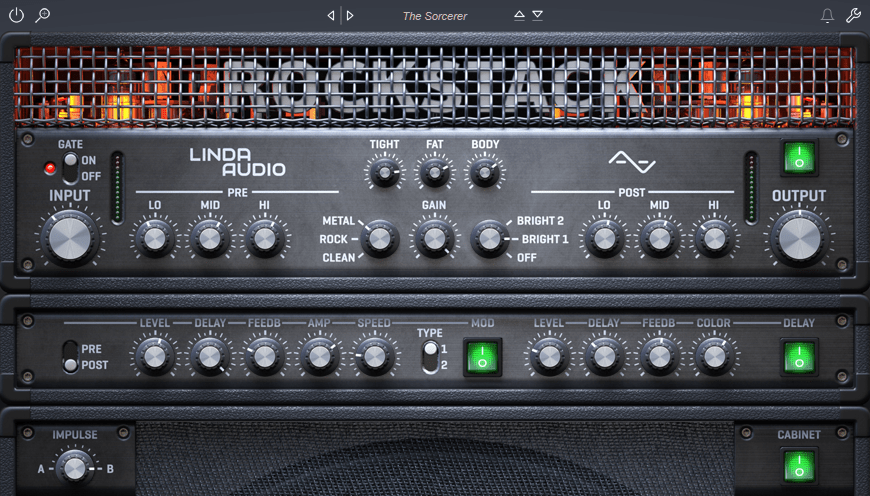If you enjoy this review and decide to grab the deal, please consider clicking through one of my links before you buy. I earn a small commission at no cost to you, which helps support this site and keep the reviews coming. Thanks!
There are dozens of amp sims on the market, most of which emulate one or more popular or famous amps. Linda Audio, in partnership with Audified, has released something a little different. Linda RockStack is a three-channel guitar amp sim that isn’t modeled after a real-world amp, but instead is its own unique animal. I took RockStack for a spin to try out these three disctinctive emulations and help you determine if it’s a good fit for your home studio.
Looks

RockStack opens to a matte black guitar amp stack with glowing orange-red tubes and a large RockStack logo peeking out of the vents along the top. The amplifier section is the top of the stack, which includes two sets of EQs, three channels, gain, input and output volumes, noise gate and bright switches, and three unique knobss called Tight, Fat, and Body. Below that is an effects module with chorus and delay with lots of options. At the bottom is the cabinet emulation with two models. All the controls are easy to find and use, with nothing hidden away from view.

Features
There’s a lot of knobs in Linda RockStack broken out into two main sections. Let’s check them out:
Amplifier

The Amplifier section is laid out right-to-left in order of signal path. There is a noise gate switch that leads into an input volume, followed by the first three-band EQ. This first-stage EQ is good for sculpting the guitar input before it hits one of the three amplifiers: Metal, Rock, or Clean. There is a gain control for dialing in the right amount of chunk, and a two-level Bright switch. Before heading into a second post-amp EQ and the output volume, there are three shaping controls called Tight, Fat, and Body. Tight changes the rectifier speed, Fat adds harmonics and low mids, and Body adds upper range. Finally, the entire amp section can be toggled off to send clean input signal to the effects and cab for use with other amp sim software.
Mod, Delay, and Cab

Mod, a chorus effect with two settings for single or multiple delay lines, has Level, Delay, Feedback, Amp, and Speed controls, while the Delay has Level, Delay, Feedback, and Color controls. The whole effects section is switchable in the signal path to before or after the amp section, and each effect can be separately toggled on or off. At the bottom, the Cab section can be blended between two impulse responses to provide a wide variety of cab tones.

Usability
One big usability benefit I found in RockStack is the EQ-Gain-EQ functionality, which gives you a lot of control over your guitar’s tone by shaping the pre- and post-amplification EQ independently. With a few twists of the knobs I was able to make the same guitar sound twangy or full. This is a huge benefit for reamping, or for those with a limited guitar arsenal.
Next, I really enjoyed the fact that RockStack is its own beast and not yet another in a sea of emulations of the same few real-world amps. Don’t get me wrong, I have emulations that I absolutely treasure that are meticulously modeled after their genuine counterparts, but it’s certainly refreshing to plug into something new and different. RockStack definitely has its own tone, which gives me that guitar shop feeling of my youth when I’d never played through a particular amp before and was sitting down to do so for the first time.
Finally, because RockStack isn’t an internet-connected monster suite of a hundred amps, it’s extremely lightweight and nimble. It loads up in moments and never once made my aging studio rig chug like some of its higher-end competitors. The next time I’m browsing my bloated plugin folder looking for an amp sim for a jam session, this feature alone will assure that RockStack ends up in my projects going forward.

Hear it in Action
To showcase what Linda RockStack can do, I created two samples using the same input track. First up is The Sorcerer preset, which is a metal amp with a heavy delay and a bright tone, followed by Rock Lead 2, a similarly bright rock amp with a tight -slapback:
Linda RockStack Review – The Bottom Line
In order to judge a plugin’s value, I have to look not only at what the plugin itself is offering for the money, but what its competitors offer at a similar price point. Linda RockStack is a great amp sim with three quality-sounding amp models and two effects, but there are other amp sims on the market that offer a bit more bang for the buck at a similar cost. If you time the sales right, you can get entire amp and effect suites with dozens of effects, amp models, and cab impulses for just a few bucks more. As such, I consider RockStack to be more of a side dish than a main course when it comes to amp sims, and have scored its value accordingly.

In conclusion, Linda Audio and Audified have put together a pretty nice product in RockStack. I’m definitely going to enjoy having RockStack in my arsenal, as its simplicity, lightweight operation, and great original sound make it perfect for jamming and laying down fresh ideas. If you’ve been skeptical to try an amp sim and are looking for a budget option to get started, RockStack is definitely worth a look. Adding it all up, I give Linda RockStack 4.5 stars and my recommendation for a budget-friendly and quick-loading option for rocking out in your home studio.

Audified and Linda Audio's guitar amp sim plugin featuring three unique amp models, noise gate, chorus, delay, and two blendable amp cab impulses. Lightweight and affordable.

